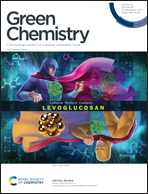Polyoxometalate-based metal–organic framework-derived bimetallic hybrid materials for upgraded electrochemical reduction of nitrogen†
Abstract
The development of high-efficiency noble-metal-free catalysts for the electrochemical nitrogen reduction reaction (NRR) to ammonia under ambient conditions has great significance in fertilizer production and energy storage. Considering the major role of Mo-nitrogenase with the FeMo cofactor in the biological N2 fixation process, the design and preparation of Mo and Fe bi-active metal based hybrid materials for the NRR under ambient conditions is proposed in this work. By using PMo12@MOF-100(Fe)@PVP (polyvinylpyrrolidone) as the precursor, two cost efficient FeMo-based electrocatalysts Fe1.89Mo4.11O7/FeS2@C and FeMoO4/FeS2@C were designed and fabricated for the NRR under room temperature and pressure conditions (RTP) via the easy-to-implement hydrothermal sulfuration method. The experiment results confirm that Fe1.89Mo4.11O7/FeS2@C (NH3 yield rate of 105.3 μg h−1 mgcat.−1, FE of 54.7% at −0.4 V vs. RHE) is more efficient towards the NRR than FeMoO4/FeS2@C (NH3 yield of 51.0 μg h−1 mgcat.−1, FE of 43.9% at −0.5 V vs. RHE) in acidic electrolytes; moreover they are all superior to most of the electrocatalysts reported to date. Further electrocatalysis of Fe1.89Mo4.11O7/FeS2@C in alkaline electrolytes (NH3 yield of 86.3 μg h−1 mgcat.−1, FE of 53.6% at −0.4 V vs. RHE) reveals the extensive NRR catalytic activity of this hybrid material. Density functional theory (DFT) calculation indicates that the NRR on Fe1.89Mo4.11O7/FeS2 has optimized nitrogen binding which facilitates the fast kinetics process through an enzymatic mechanism, and the protonation of N2 to form *N2H species is the potential-determining step (PDS) with the maximum ΔG values (+0.61 eV). This work opens up a significant opportunity to develop a family of efficient and robust FeMo-based electrocatalysts for the NRR under ambient conditions by using polyoxometalate-based metal–organic frameworks (POMOFs) as precursors by tuning metal sources.



 Please wait while we load your content...
Please wait while we load your content...